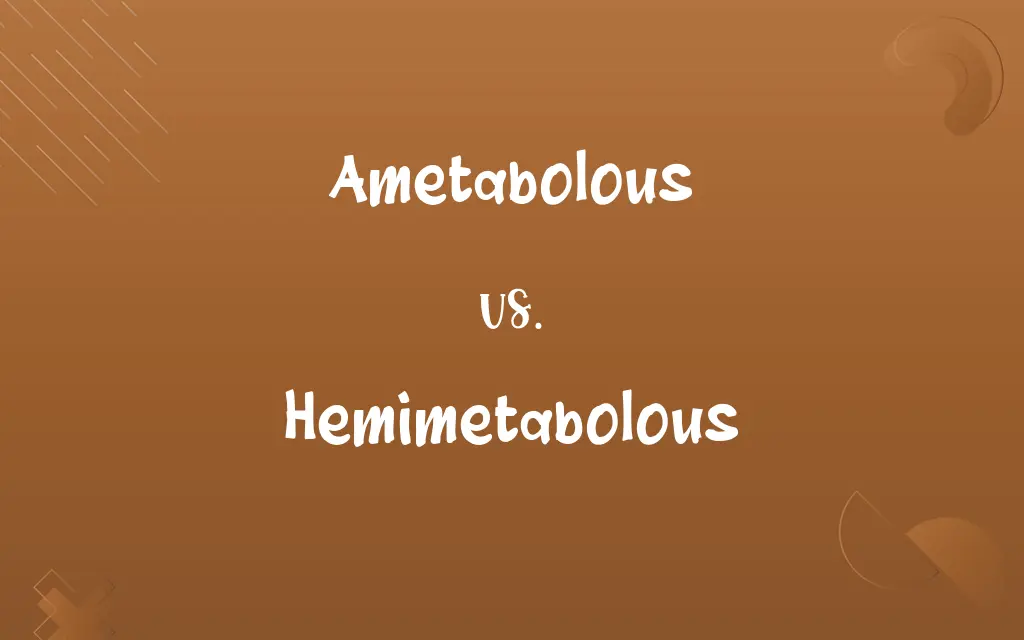Ametabolous vs. Hemimetabolous: Know the Difference

By Shumaila Saeed & Dua Fatima || Published on March 4, 2024
Ametabolous insects do not undergo metamorphosis, maintaining a similar appearance from hatching to adulthood. Hemimetabolous insects undergo partial metamorphosis, with nymph stages resembling adults but lacking wings.

Key Differences
Ametabolous development, seen in insects like silverfish, involves no significant physical changes post-hatching. These insects emerge as miniature adults and grow larger with each molt without changing form. Hemimetabolous insects, such as grasshoppers, experience more noticeable changes. They hatch into nymphs, which gradually develop into adults through successive molts, gaining wings and reproductive capabilities.
Shumaila Saeed
Mar 04, 2024
The ametabolous life cycle is simpler, lacking distinct larval or pupal stages, facilitating a straightforward growth process directly from egg to adult. This contrasts with the hemimetabolous process, which includes several nymph stages, each resembling the adult form more closely than the last and culminating in the final molt into adulthood.
Dua Fatima
Mar 04, 2024
Ametabolous insects are often considered more primitive, thriving in stable environments where rapid changes are unnecessary. Hemimetabolous insects, with their partial metamorphosis, show a greater capacity for adapting to varied environments, as each nymph stage can exploit different niches or resources.
Shumaila Saeed
Mar 04, 2024
Reproductive strategies also differ, with ametabolous insects typically producing fewer eggs but more frequently over their lifetime. Hemimetabolous insects might have more defined breeding seasons, with nymphs developing in synchronization with environmental conditions favorable for their adult form.
Shumaila Saeed
Mar 04, 2024
The study of these developmental processes provides insight into evolutionary biology, illustrating how different life cycle strategies contribute to the survival and success of insect species across diverse ecosystems.
Dua Fatima
Mar 04, 2024
ADVERTISEMENT
Comparison Chart
Physical Changes
Minimal, grow larger with age
Significant, develop wings and reproductive parts
Shumaila Saeed
Mar 04, 2024
Adaptation
Suited to stable environments
Capable of adapting to varied environments
Shumaila Saeed
Mar 04, 2024
Reproductive Strategy
Continuous, with frequent egg production
Often seasonal, synchronized with environmental conditions
Hifza Nasir
Mar 04, 2024
ADVERTISEMENT
Ametabolous and Hemimetabolous Definitions
Ametabolous
Continuous reproduction cycle.
Silverfish lay eggs throughout their lives without a breeding season.
Hifza Nasir
Feb 27, 2024
Hemimetabolous
Insects undergo partial metamorphosis with nymph stages.
Grasshoppers develop wings and reproductive organs as they mature.
Dua Fatima
Feb 27, 2024
Ametabolous
Minimal physical changes post-hatching.
A newly hatched firebrat looks like a miniature adult.
Shumaila Saeed
Feb 27, 2024
Hemimetabolous
Nymphs resemble adults but lack wings.
Young dragonflies (nymphs) live in water before becoming airborne adults.
Shumaila Saeed
Feb 27, 2024
Ametabolous
Lacks distinct juvenile stages.
Adult and juvenile bristletails look alike, differing only in size.
Shumaila Saeed
Feb 27, 2024
ADVERTISEMENT
Hemimetabolous
Often have seasonal breeding patterns.
Cicadas emerge in large numbers synchronizing with optimal environmental conditions.
Dua Fatima
Feb 27, 2024
Ametabolous
Suited for stable environments.
Silverfish thrive in consistent, humid conditions.
Dua Fatima
Feb 27, 2024
Hemimetabolous
Adapt to varied environments through developmental stages.
Mayfly nymphs exploit aquatic niches before terrestrial adult life.
Dua Fatima
Feb 27, 2024
Ametabolous
Insects grow directly from eggs to adults without metamorphosis.
Silverfish remain visually consistent throughout their life.
Dua Fatima
Feb 27, 2024
Hemimetabolous
Defined juvenile to adult transformation.
A cricket progresses through several nymph stages before reaching adulthood.
Shumaila Saeed
Feb 27, 2024
Repeatedly Asked Queries
What is the main difference between ametabolous and hemimetabolous development?
Ametabolous insects do not undergo metamorphosis, while hemimetabolous insects experience partial metamorphosis with distinct nymph stages.
Dua Fatima
Mar 04, 2024
How does reproduction differ between ametabolous and hemimetabolous insects?
Ametabolous insects tend to reproduce continuously, while hemimetabolous insects may have more defined breeding seasons.
Dua Fatima
Mar 04, 2024
Why do hemimetabolous insects have nymph stages?
Nymph stages allow for gradual development into the adult form, adapting to different environmental niches along the way.
Dua Fatima
Mar 04, 2024
Can ametabolous insects fly?
No, ametabolous insects like silverfish do not develop wings and therefore cannot fly.
Shumaila Saeed
Mar 04, 2024
What role do nymphs play in the ecosystem?
Nymphs can occupy different ecological roles than their adult counterparts, contributing to biodiversity and ecosystem function.
Shumaila Saeed
Mar 04, 2024
Are there any advantages to ametabolous development?
It offers simplicity and efficiency in stable environments, with less energy expended on metamorphic changes.
Dua Fatima
Mar 04, 2024
Are ametabolous insects considered more primitive?
Yes, ametabolous development is seen as more primitive, often associated with insects in stable, unchanging environments.
Dua Fatima
Mar 04, 2024
How do hemimetabolous insects adapt to their environment?
Through their nymph stages, they can exploit different ecological niches, adapting to varied conditions as they grow.
Shumaila Saeed
Mar 04, 2024
Do all insects undergo metamorphosis?
No, insects exhibit a range of developmental processes, from no metamorphosis (ametabolous) to complete metamorphosis (holometabolous).
Hifza Nasir
Mar 04, 2024
What kind of environments do ametabolous insects prefer?
They thrive in stable environments where consistent conditions prevail.
Hifza Nasir
Mar 04, 2024
What is the significance of the nymph stage in hemimetabolous insects?
It allows for gradual adaptation and development, enabling survival in diverse environments.
Shumaila Saeed
Mar 04, 2024
Can the developmental process of an insect tell us about its evolutionary history?
Yes, the type of metamorphosis an insect undergoes can provide insights into its evolutionary adaptations and ecological niches.
Shumaila Saeed
Mar 04, 2024
How do scientists study the development of ametabolous and hemimetabolous insects?
Through field observations, laboratory experiments, and genetic studies to understand their life cycles, ecological roles, and evolutionary significance.
Shumaila Saeed
Mar 04, 2024
How do hemimetabolous insects benefit from their developmental process?
Their partial metamorphosis allows for flexibility in adapting to changing environments and exploiting different ecological niches at each life stage.
Hifza Nasir
Mar 04, 2024
What challenges do ametabolous insects face in changing environments?
Their lack of metamorphosis may limit their ability to adapt to rapid environmental changes, potentially affecting their survival.
Dua Fatima
Mar 04, 2024
Share this page
Link for your blog / website
HTML
Link to share via messenger
About Author
Written by
Shumaila SaeedShumaila Saeed, an expert content creator with 6 years of experience, specializes in distilling complex topics into easily digestible comparisons, shining a light on the nuances that both inform and educate readers with clarity and accuracy.
Co-written by
Dua Fatima








































































